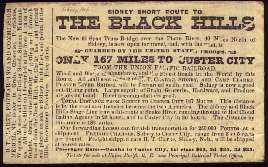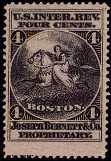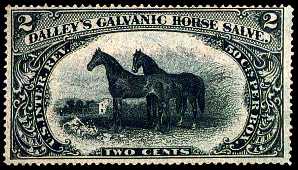
|
<<<< |

|
>>>> |

|

TRAINS ON U. S. STAMPS
and POSTAL STATIONERY
page 1a

Embossed postcard with train image - 20th Century Limited |
3¢ CENTENNIAL STAMPED ENVELOPES - 1876
The Scott catalog gives us few details about these envelopes, except that they were printed by Plimpton Manufacturing Co, (of Hartford, Conn.), and that there are four varieties, U218, 219, 220, and 221. 218 is shown above, with red indicium, and a single line under "POSTAGE". 219 is green, also with a single line. 220 is red, with a double line under "POSTAGE". And 221, also shown above, is green, with double line. 218, 219, and 221 retail for about $50 each, while 220 is one of the scarcest and most valuable U.S. postal stationery items, with an italicized Scott catalog value of $30,000 as an entire! (The italics means there are few known examples, and the item trades seldom, so the price is somewhat a guess.) Most authorities believe it was a favor printing, and should not have reached private hands at all. We can deduce from the design and the year of issue that these were issued to commemorate the U.S. Centennial. I have always thought it odd there were no special postage stamps issued that year, but I also find it refreshing that they didn't think to exploit it that way. Yet they did issue this. And, as I mention above in connection with the 3¢ Locomotive stamp of 1869, they did issue reprints of all stamps issued up to that time, for a special display at the Centennial Exhibition in Philadelphia that year. The USPS publicity for the release of U582 (click here) states that this 1876 envelope was released at the Centennial Exhibition, which would certainly have made sense, but I can find no other verification for that assertion. George B. Sloan wrote about this issue, in several of his columns in 1940, 1941, and 1954, that some of the envelopes were actually printed at the Exhibition, as part of the USPS display there. He also noted that the two colors were related to the two sizes in which the envelope was issued, the green being a "No. 3, full letter," and the red being "No. 4-1/2, commercial." All the copies I have seen agree with that assertion, the green being 83x138mm, and the red 85x148. Furthermore, the double-line die - Scott U220 and 221 -was the one used at the Exhibition, and is called therefore the "Philadelphia Die", while the single-line die is the "Hartford Die." Since all printing at the Exhibition was supposedly in green, this supports the contention that U220 was never officialy issued. The train in the design is a classic 4-4-0 steam locomotive with tender and mail car, and one of my favorite stamp trains. It is unusually accurate, especially considering the means used to reproduce it, and there is sufficient detail to say that it could have been based on a Baldwin locomotive of about 1870. The leading truck looks too small, and I am sure an expert could find other inaccuracies, but it is still very well done. Above the train is a Post Rider, and the two images are perfectly appropriate. In 1776, pre-(or at least early- )Industrial Revolution, the Post Rider (or mounted mail carrier) was still the primary mover of mail between towns, with twenty-odd of them employed by Benjamin Franklin, recently appointed Postmaster General of the united colonies. By 1876 the train system was the backbone of the Nation, and the Railway Mail Service was well established, having been in existence twelve years, with 850 Railway Mail Clerks employed full time by the USPOD. We know the car being pulled by the train is a mail car, by the way, not simply because of the context - old vs. new ways of carrying mail - but also by the letters "USM" (U.S. MAIL) on the side of the car - you need a good copy to see them, but they are there. You should be able to see at least the "U" on the enlarged versions of the indicia - click on the images. This design was reissued (modified for the occasion, of course) in 1976, for the Bicentennial - more on that here.
There was no official issue date for these envelopes, but the Centennial Exhibition opened May 10, 1876, so that should be the earliest possible use for Scott 219. Postal stationery does not get the attention stamps do, so I cannot find an EKU for Scott 218, but I assume it was available earlier. Any information about this question will be appreciated - email me at posterstampcc@gmail.com Here's a great item - a Scott U221 entire used by a Western express carrier: This was offered in the Siegel Auction Galleries May 18, 2002 Rarities sale (sale 846, lot number 2006), with an estimated value of $1,000 to $1,500. Here's the auction catalog decription:
It sold for $950. |
|||||
GARDNER, BEER & CO MATCHESPrivate Die Proprietary Tax Stamp - December, 1877
This stamp is described in the ATA World Railways Philatelic Handbook, which lists all stamps of the world with a rail theme, thus: 1¢ black on pink paper, 4-4-0 Steam locomotive &
tender on "Match" stamp I include that partly to prove that the pink is not your monitor or my scan, it's intentional. The locomotive shown, while quite detailed, and accurate as far as it goes, has been squashed to fit the stamp's circular vignette area, giving it the appearance somewhat of a toy train. I doubt there was ever a working steam locomotive built to those proportions. The stamps date from a twenty-one year period, 1862-1883, during and after the Civil War, when special taxes were levied by Congress on matches, proprietary medicines, perfumes, and playing cards, AND the manufacturers of those goods were allowed to design their own stamps, and to have their own dies and plates made. Companies paid a flat fee to the holder of the printing contract (initially Butler & Carpenter, then National Bank Note, then American Bank Note, and for the final three years, the U.S. Bureau of Printing and Engraving) for the creation of the dies and plates, and received a discount on the printing costs, PLUS essentially free advertising. The implied government endorsement of their products (that "U.S.INTER.REV.") didn't hurt either. Over 500 firms took advantage of the opportunity. Many of them also produced Advertising Covers as well, making that a popular joint collecting area. I don't see how anyone could help loving this stamp. The centering on my copy is less than perfect, and there's that stain in the top left, but this is a pricey item, with a catalog value of $125, so I probably bought it relatively cheaply. For a long time I failed to read all the text, and thought this was a tax stamp for a bottle of beer -wrong. It paid the tax on a box or package of 100 matches.
Private Die Proprietary tax stamps are a rich and fascinating area to collect, not least because many of the designs are so unlike what we expect to see on stamps of that era - I saw several exceptional, award-winning exhibits of them at Westpex in San Francisco last May, including one of original boxes, bottles, and tins with the stamps still affixed. I suspect those exhibits would have been shunned not so many years ago, when Philatelic Exhibition meant "postage stamps only!" But in recent years almost anything produced by the government or under its authority has become eligible, so all type of Revenues, including Duck Stamps, are acceptable for display. Below are a few of my favorites of the other "Match & Medicine" stamps, WITHOUT trains. (The Gardner & Beer stamp is the only match stamp with a train.) No, I don't collect these, I have enough collections already.
|
|||
US TRAINS
|
Send feedback to the webmaster: CLICK HERE
Revised -- 01/27/2008











